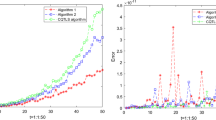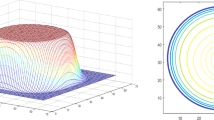Abstract
To reduce the hardware implementation resource consumption of the two-dimensional transform component in H.266 VVC, a unified hardware structure is proposed that supports full-size Discrete Cosine Transform (DCT), Discrete Sine Transform (DST), and full-size Low-Frequency Non-Separable Transform (LFNST). This paper presents an area-efficient hardware architecture for two-dimensional transforms based on a general Regular Multiplier (RM) and a high-throughput hardware design for LFNST in the context of H.266/VVC. The first approach utilizes the high-frequency zeroing characteristics of VVC and the symmetric properties of the DCT-II matrix, allowing the RM-based architecture to use only 256 general multipliers in a fully pipelined structure with a parallelism of 16. The second approach optimizes the transpose operation of the input matrix for LFNST in a parallelism of 16 architecture, aiming to save storage and logic resources.










Similar content being viewed by others
Data availability
No datasets were generated or analyzed during the current study.
References
Bross, B., Chen, J., Liu, S., et al: Versatile video coding editorial refinements on draft 10 [eb/ol] ((2020-11-24)[2022-11-15]). https://jvet-experts.org/doc_end_user/documents/20_Teleconference/wg11/JVET-T2001-v2.zip
Bross, B., Wang, Y.K., Ye, Y., Liu, S., Chen, J., Sullivan, G.J., Ohm, J.R.: Overview of the versatile video coding (VVC) standard and its applications. IEEE Trans. Circuits Syst. Video Technol. 31(10), 3736–3764 (2021). https://doi.org/10.1109/TCSVT.2021.3101953
Sullivan, G.J., Ohm, J.R., Han, W.J., Wiegand, T.: Overview of the high efficiency video coding (HEVC) standard. IEEE Trans. Circuits Syst. Video Technol. (2012). https://doi.org/10.1109/tcsvt.2012.2221191
Bossen, F., Suhring, K., Wieckowski, A., Liu, S.: VVC complexity and software implementation analysis. IEEE Trans. Circuits Syst. Video Technol. 31(10), 3765–3778 (2021). https://doi.org/10.1109/tcsvt.2021.3072204
Zhao, X., Kim, S.H., Zhao, Y., Egilmez, H.E., Koo, M., Liu, S., Lainema, J., Karczewicz, M.: Transform coding in the VVC standard. IEEE Trans. Circuits Syst. Video Technol. (2021). https://doi.org/10.1109/tcsvt.2021.3087706
Yan, S.: High efficiency video coding. Chin. J. Comput. 36, 2340–2355 (2013)
Bross, B., Andersson, K., Blaser, M., Drugeon, V., Kim, S.H., Lainema, J., Li, J., Liu, S., Ohm, J.R., Sullivan, G.J., Yu, R.: General video coding technology in responses to the joint call for proposals on video compression with capability beyond HEVC. IEEE Trans. Circuits Syst. Video Technol. 30(5), 1226–1240 (2020). https://doi.org/10.1109/tcsvt.2019.2949619
Silveira, B., Neto, L., Palomino, D., Diniz, C., Correa, G.: Multiple transform selection hardware design for 4k@60fps real-time versatile video coding. In: 2022 IEEE International Symposium on Circuits and Systems (ISCAS), pp. 1–5 (2022). https://doi.org/10.1109/ISCAS48785.2022.9937964
Silveira, B., Palomino, D., Diniz, C., Correa, G.: A hardware design for the multi-transform module of the versatile video coding standard. In: 2023 36th SBC/SBMicro/IEEE/ACM Symposium on Integrated Circuits and Systems Design (SBCCI), pp. 1–6 (2023). https://doi.org/10.1109/SBCCI60457.2023.10261970
Garrido, M.J., Pescador, F., Chavaríras, M., Lobo, P.J., Sanz, C.: A high performance FPGA-based architecture for the future video coding adaptive multiple core transform. IEEE Trans. Consum. Electron. 64(1), 53–60 (2018). https://doi.org/10.1109/TCE.2018.2812459
Garrido, M.J., Pescador, F., Chavarrías, M., Lobo, P.J., Sanz, C.: A 2-D multiple transform processor for the versatile video coding standard. IEEE Trans. Consum. Electron. 65(3), 274–283 (2019). https://doi.org/10.1109/TCE.2019.2913327
Garrido, M.J., Pescador, F., Chavarrías, M., Lobo, P.J., Sanz, C., Paz, P.: An FPGA-based architecture for the versatile video coding multiple transform selection core. IEEE Access 8, 81887–81903 (2020). https://doi.org/10.1109/ACCESS.2020.2991299
Fan, Y., Zeng, Y., Sun, H., Katto, J., Zeng, X.: A pipelined 2D transform architecture supporting mixed block sizes for the VVC standard. IEEE Trans. Circuits Syst. Video Technol. 30(9), 3289–3295 (2020). https://doi.org/10.1109/TCSVT.2019.2934752
Dempster, A., Macleod, M.: Use of minimum-adder multiplier blocks in fir digital filters. IEEE Trans. Circuits Syst. II Analog Digit. Signal Process. 42(9), 569–577 (1995). https://doi.org/10.1109/82.466647
Goebel, J., Agostini, L., Zatt, B., Porto, M.: Low-frequency non-separable transform hardware system design for the VVC encoder. In: 2022 35th SBC/SBMicro/IEEE/ACM Symposium on Integrated Circuits and Systems Design (SBCCI), pp. 1–6 (2022). https://doi.org/10.1109/SBCCI55532.2022.9893228
Koo, M., Salehifar, M., Lim, J., Kim, SH.: Low frequency non-separable transform (LFNST). In: 2019 Picture Coding Symposium (PCS), pp. 1–5 (2019). https://doi.org/10.1109/PCS48520.2019.8954507
Mert, AC., Kalali, E., Hamzaoglu, I.: An FPGA implementation of future video coding 2D transform. In: 2017 IEEE 7th International Conference on Consumer Electronics-Berlin (ICCE-Berlin), pp. 31–36 (2017). https://doi.org/10.1109/ICCE-Berlin.2017.8210582
Hao, Z., Sun, H., Xiang, G., Zhang, P., Zeng, X., Fan, Y.: A reconfigurable multiple transform selection architecture for VVC. IEEE Trans. Very Large Scale Integr. Syst. 31(5), 658–669 (2023). https://doi.org/10.1109/TVLSI.2023.3245291
Goebel, J., Costa, V., Agostini, L., Zatt, B., Porto, M.: A high-throughput design for the H.266/VVC low-frequency non-separable transform. In: 2022 IEEE International Symposium on Circuits and Systems (ISCAS), pp. 1798–1802 (2022). https://doi.org/10.1109/ISCAS48785.2022.9937597
Acknowledgements
This work was supported in part by the National Key R &D Program of China under Grant 2022C01068, and in part by National College Students’ innovation and entrepreneurship training program under Grant 202310336045.
Ethics declarations
Conflict of interest
The authors declare that there is no conflict of interest.
Additional information
Publisher's Note
Springer Nature remains neutral with regard to jurisdictional claims in published maps and institutional affiliations.
Rights and permissions
Springer Nature or its licensor (e.g. a society or other partner) holds exclusive rights to this article under a publishing agreement with the author(s) or other rightsholder(s); author self-archiving of the accepted manuscript version of this article is solely governed by the terms of such publishing agreement and applicable law.
About this article
Cite this article
Zhang, J., Sheng, Q., Pan, R. et al. Hardware architecture optimization for high-frequency zeroing and LFNST in H.266/VVC based on FPGA. J Real-Time Image Proc 21, 90 (2024). https://doi.org/10.1007/s11554-024-01470-4
Received:
Accepted:
Published:
DOI: https://doi.org/10.1007/s11554-024-01470-4




